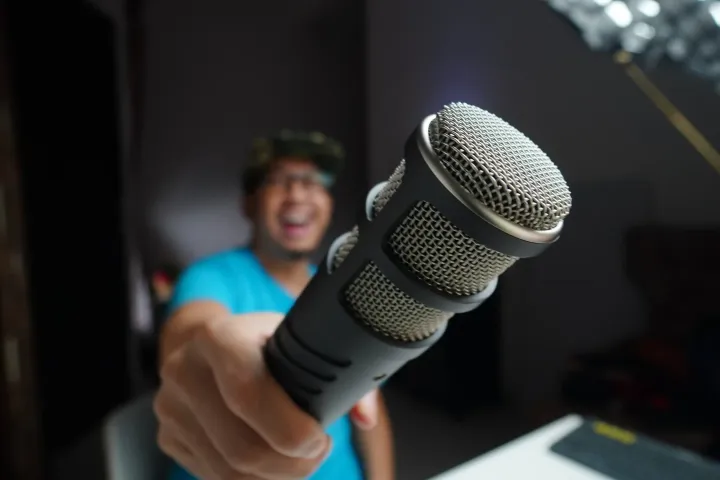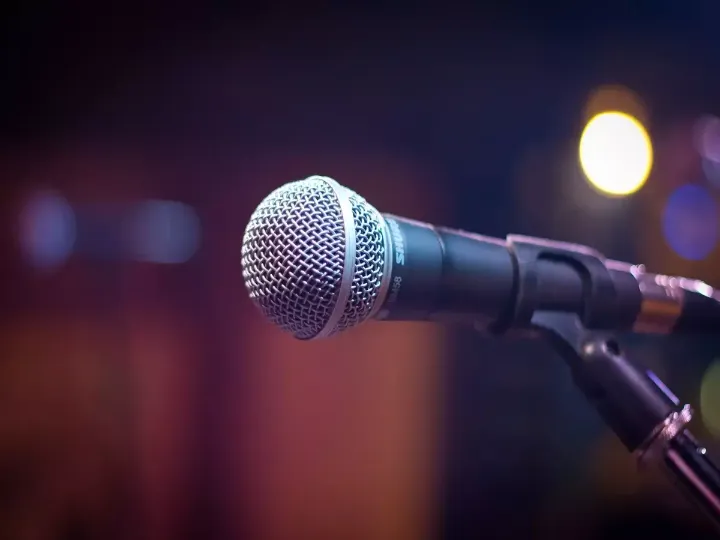Dynamic microphones are dubbed “multipurpose” microphones due to their extensive array of applications. Some dynamic microphones are superior than others for specific applications, which can make purchasing one somewhat confusing.
To assist you in making a decision, we’ve produced a list of the best dynamic microphones in 2023. Each microphone is described by its primary function and strength, such as karaoke, performance, professional, or studio use. We will also discuss how to choose the correct microphone, how much you should expect to pay for a good one, and what dynamic microphones are used for.
Table of Contents
OUR TOP PICK
Singing Machine SMM-205 Dynamic Microphone
[amazon box=”B000XI6O2W”]
The Singing Machine SMM-205 is a dynamic microphone designed for karaoke alone. It has a one-dimensional characteristic and high-sensitivity equipment. It will have the capacity to generate a loud, bright sound. This microphone has a slight echo, however if it is only used for karaoke, this is not a problem.
This microphone’s exceptional sensitivity will make every sound that passes through it extremely audible. This implies that any breathing, mic contact, or side/background noises will be captured. This is a desirable feature for karaoke, as it will showcase the singer’s voice and the music behind them.
The Singing Machine is most suited for smaller settings, such as house parties, although it can also be used in bars and karaoke venues. Due to the echo, you may not be able to hear every word projected if you are seated in the rear of a huge room. If you’re searching for a home/studio karaoke microphone, this is an excellent choice.
Audio-Technica ATR2100-USB Dynamic Microphone
[amazon box=”B004QJOZS4″]
This microphone features what is known as an extended frequency. Extended frequencies are comparable to microphones with a flat frequency response, such as condenser mics. The extended frequency can result in a sound that is less variable.
It aims to provide natural sounds, but if you’re in a band where you need your vocals to stand out from the music, this is probably not the greatest option.
The Audio-Technica ATR2100-USB is hence appropriate for smaller venues. You won’t obtain the extreme highs and lows that are possible with other frequencies, but if you’re not using it for a performance, you won’t need them. This microphone is suitable for podcasts, voiceovers, and studio recordings.
It is fitted with a USB connector, allowing you to plug it immediately into your computer, which is our favorite feature. This simplifies the recording procedure, as most software utilized by artists will detect the microphone.
Pyle-Pro PDMIC58 Dynamic Microphone
[amazon box=”B003GEBGA0″]
This type is an excellent entry-level microphone for anyone learning how to project their voice into a microphone. It is frequently utilized by music teachers and band directors to aid improve the vocal techniques of their students. Some professional musicians may also utilize them, but this model is primarily designed for students.
This model is our favorite because it includes a chord (most mics do not, unless you upgrade), is made entirely of metal, and features an anti-dent ring. It is a sturdy microphone, which is uncommon in such inexpensive devices. It does not have an adapter, however they are simple and inexpensive to acquire independently.
The Pyle-Pro PDMIC58 is a cardioid microphone, so you will once again receive direct sound from the front. The ambient noise level will be minimal. It boasts an extremely broad frequency response and a built-in pop filter.
Behringer Ultravoice Xm8500
[amazon box=”B0002KZAKS”]
This Behringer Ultravoice XM8500 is an excellent choice for bands with two or more members. This is because to its superior shock mount mechanism. Your hands on the microphone, your bandmates, and the high-pitched sound of the audience in front of you will not be picked up.
Similar to other dynamic microphones, it is durable and resistant to drops. If the microphone is dented, the sound will not be compromised. This Behringer product also offers a 50Hz to 15kHz frequency response, allowing you to regulate how vocals are projected. This model is meant to provide a wider range of sound amplification if you desire to hear more of it.
This model does not include a cord or cable; therefore, one must be purchased separately. Consequently, this is an excellent inexpensive dynamic microphone. Buying the cord will not incur a significant additional cost.
Shure SM58-LC
[amazon box=”B000CZ0R42″]
The cardioid polar pattern of the Shure SM58-LC prevents it from picking up sound from the sides or rear. Your voice will not be entirely segregated. You will hear everything in front of the microphone (like your guitar, for example).
However, it will pick up your voice more dramatically than any other sound in the room. This recording microphone is also dynamic; it will sound wonderful in a recording studio.
This variant features a frequency increase of 4,000 Hz and a strong presence boost. Your highs and lows will be accurately reproduced, and you will be able to adjust the equalization to suit your needs. This makes it ideal for sound reinforcement and recording in the studio. It features a built-in spherical wind and pop filter, which is essential for any vocal performer.
It includes a storage pouch with a zipper and a mic stand adaptor, and this particular type allows for the addition of a cable and an on/off switch. The standard model lacks a wire and a switch. You may upgrade to whatever meets your requirements.
Shure SM57-LC
[amazon box=”B0000AQRST”]
The Shure SM57-LC is among the most resilient microphones in our testing. This model is constructed primarily for road and stadium use, so it is durable. The mic’s head, or built-in windshield, is comprised of a material that is extremely durable and nearly unbreakable. This safeguards the valuable materials on the interior, including the diaphragm, coil, and magnetic core.
It is also square, making it slightly less susceptible to denting when dropped. This does not mean that it cannot be dented; most microphones can. But there will be no loss in input quality with this one.
While all dynamic microphones are considered versatile, many have particular strengths. Some are particularly skilled with voice, while others excel with percussion instruments, etc. This concept is equally effective for instruments and vocals.
The SM57 is not tuned to a certain frequency like other microphones, therefore there is a wider frequency range to pick from. Due to its non-specific tuning range, this microphone is ideal for instruments.
BUYING GUIDE
To make sense of the voiceover equipment market, you will require help. Before deciding, it is vital to understand the characteristics of a dynamic microphone.

Polar Patterns
The form of a microphone’s sensitivity field, often known as its polar pattern, refers to the directions from which the microphone accepts or rejects incoming sounds. These are the most often occurring polar patterns: –
- Unidirectional: A cardioid microphone can only be used in front of the microphone. Ideal for usage in applications including voiceovers, singing, and streaming.
- Bidirectional: The microphone captures sound from both in front of and behind it, making it ideal for private conversations and interviews.
- Omnidirectional: An omnidirectional microphone is ideal for conducting interviews around a circular table since it detects sound from all directions.
Frequency Response
The frequency response of a microphone describes the frequency range it will capture when recording sound. This range’s lowest and highest frequencies are measured in Hertz, the unit of frequency measurement. A microphone having a frequency response range of around 80 Hz to 15 kHz, for instance, would be an ideal option for use as a vocal microphone.
Snares and toms, on the other hand, require a lower frequency range, beginning around 50 Hz, but a bass drum mic requires a frequency range as low as 40 Hz or even 30 Hz.
Sensitivity

The sensitivity of a microphone is measured in a variety of methods, and its value shows how faint a sound it can detect. Knowing that the microphone’s sensitivity rises as the number decreases is likely all that is required to comprehend this notion. It holds true notwithstanding the application of a different system.
The decibel scale is used to measure what is known as the sound pressure level (SPL), which is another term for loudness.
In this sense, it is the opposite of sensitivity, as it describes the loudest sound a microphone can handle. Consider a microphone that must accommodate loud instruments such as drums. In such a circumstance, this is a significant factor, and 100 decibels (dB) is the typical level, while 130 dB is a high SPL.
Impedance
When purchasing a microphone, it is vital to verify the impedance and ensure that it has the correct value. Mics are often intended for use with low impedance loads and are engineered to have low impedance.
Due to the high impedance of these microphones, the input impedance of an amplifier to which a crystal or ceramic microphone is connected must be at least one megaohm (M).
Closeness Effect
The rise in low frequencies audible as one approaches a microphone is known as the proximity effect. As a result of the proximity effect, rappers and rock singers who wish to increase their low-end power can gain major benefits.
On the current market, some microphones are created with less proximity impact, while others give more. As a result, certain manufacturers must include tone variation lines in their frequency charts when the mic is nearby in order to inform customers of what to expect when recording.
A toggle for On and Off
To avoid accidentally turning off the microphone, many professional portable devices lack an on/off switch. However, some individuals still prefer this additional control, which might be useful for smaller parties where you must constantly step away from the microphone.
CONCLUSION
There are a plethora of vocal microphones on the market, which might be bewildering for those who are unaware with certain crucial microphone characteristics. If you’ve read our guide, we’re confident that you now know what type of best dynamic microphone you need and which selections are the greatest.

